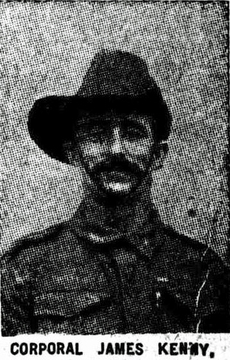KENNY, James
| Service Number: | 1680 |
|---|---|
| Enlisted: | Not yet discovered |
| Last Rank: | Private |
| Last Unit: | 47th Infantry Battalion |
| Born: | Not yet discovered |
| Home Town: | Not yet discovered |
| Schooling: | Not yet discovered |
| Occupation: | Not yet discovered |
| Memorials: |
World War 1 Service
| 20 Apr 1916: | Involvement Private, 1680, 47th Infantry Battalion, --- :embarkation_roll: roll_number: '19' embarkation_place: Sydney embarkation_ship: SS Hawkes Bay embarkation_ship_number: '' public_note: '' | |
|---|---|---|
| 20 Apr 1916: | Embarked Private, 1680, 47th Infantry Battalion, SS Hawkes Bay, Sydney |
Help us honour James Kenny's service by contributing information, stories, and images so that they can be preserved for future generations.
Add my storyBiography contributed by Aubrey Bairstow
James Kenny was born in Brisbane and stated that he was a 25 year old labourer living with his father at Breakfast Creek, Brisbane when he enlisted in January 1916. He was posted to the 36th Battalion and embarked 20 April 1916.
On 17 May at Tel El Kebir he was posted to 47th Battalion and embarked for France on 2 June, Arriving in France on 9 June 1916, the 47th entered the trenches of the Western Front for the first time on 3 July. It participated in its first major battle at Pozieres. Initially, the battalion provided working parties during the 2nd Division's attack on 4 August, and then, with its own division, defended the ground that had been captured. The 47th endured two stints in the heavily-contested trenches of Pozieres, as well as a period in reserve.
After Pozieres, the battalion spent the period up until March 1917 alternating between duty in the trenches and training and rest behind the lines.
He was promoted to Temporary Corporal in February 1917 and the award of his Military Medal was confirmed on 27 March 1917.
London Gazette citation “for carrying out valuable reconnaissance in No Man's Land under fire during operations at Gueudecourt from 10-20 February 1917 in which he displayed bravery & initiative of a high order in reconnoitring the enemy wire for a lateral distance of 1000 yds. His work was chiefly responsible for our advance of 500 yds beside giving valuable information to battalions on our flank for their successful operations. On one occasion he remained under the enemy wire for 12 hours in day-light & altogether was unceasing & tireless in devotion to his duty”.
On 11 April the 47th took part in the attack mounted against the heavily defended village of Bullecourt - part of the formidable Hindenburg Line to which the Germans had retreated during February and March. Devoid of surprise, and dependent upon the support of unreliable tanks, the attack failed.
His first wounding was 7 June . A gun shot wound to his arm saw him sent to England for recovery. He didn’t rejoin his unit until 1 September, by which stage they were in Belgium.
His second wounding was 12 October 1917, at Passchendaele, where he sustained gun shot wounds to his head and right leg. He was again returned to England for recovery, embarking for France on 1 February 1918, eventually returning to his unit a week later.
The 47th rotated in and out of the front line throughout the winter of 1917-18. In the spring of 1918, it played a role in turning the great German Spring Offensive by defeating attacks around Dernancourt during the last days of March and the first days of April 1918. One of the battalion's actions at Dernancourt is depicted in a diorama at the Australian War Memorial.
For his valorous actions at Dernancourt Sergeant Stanley MacDougall was awarded the Victoria Cross
On 28 March 1918 he suffered his third wounding – a gun shot wound to his right thigh and leg. The leg was amputated in England on 17 April 1918. His recovery was slow and he returned to Australia on 23 July 1918. He was discharged in February 1919.
After the war he made a living repairing boots. On one occasion he had a bad fall in the street and he seems to have suffered greatly from the ongoing effects of his wounds.
He married in 1932 and died of a heart attack in April 1943.
His wife tried to get his death deemed due to war service but was not successful.











